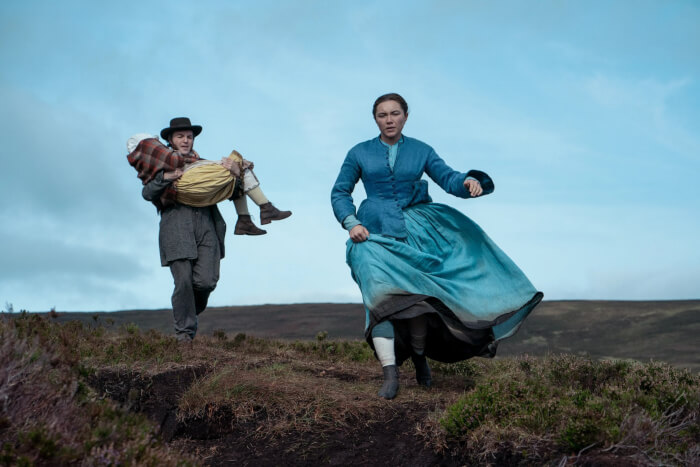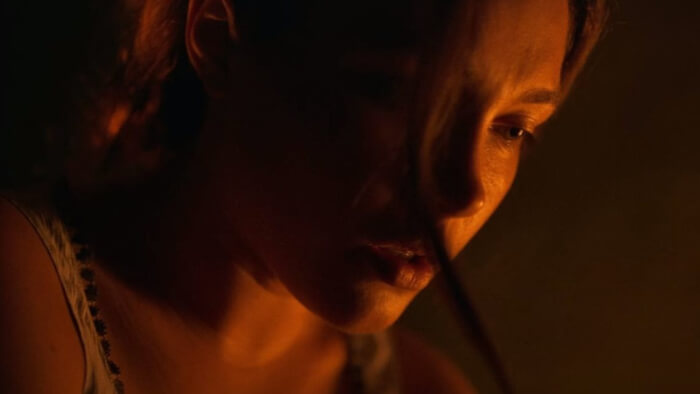The psychological period drama starring Florence Pugh has an unconventional beginning and ending, to say the least. If you just watched The Wonder on Netflix, you might have questions about that unconventional ending. The psychological drama from Chilean director Sebastián Lelio asks you to believe in the power of storytelling and how it can alter reality. Here is the explanation of ‘The Wonder’ for you to find out why the movie opens and ends in such a complicated way.
Warning: Spoilers ahead.
The camera then stops on the interior of a ship sailing to Ireland in 1862, where the Great Famine "still casts a long shadow and the Irish hold England responsible for that devastation." It zooms in on Florence Pugh, who plays English nurse Lib Wright, the main character of the tale.
This framing also sets us up to be aware of the transportive power of storytelling -- you're quickly immersed in the creaking, drippy, smokey world of the ship and Nurse Wright's journey, a journey the narrator has invited us to believe in.
Not long into Nurse Wright's stay with the O'Donnell family, we see young Anna's mother lean in close to her daughter's face during a nightly prayer. It isn't clear if we're witnessing a loving kiss on the forehead or something more disturbing. Nurse Wright soon escalates her watch over the miracle patient by insisting the O'Donnells no longer come into Anna's room. From this point onward, Anna's condition deteriorates rapidly.
About two-thirds through the film, after summoning the committee, Nurse Wright reveals her assessment of the situation: "Anna's mother, Mrs. O'Donnell, has been passing her food from her own mouth. She cups her face and kisses her good morning and good night, and she feeds her daughter with each kiss, like a bird." When her mother is prevented from kissing her, Anna quickly becomes ill, no longer receiving any sustenance at all.
She builds a report of Anna's death so that the committee will not charge her, and she burns down the O'Donnell's house to conceal evidence of a body. Nurse Wright, William, and Nan escape Ireland and arrive in Sydney disguised as the Cheshire family. There, we see them sharing a fancy meal, with Nan seen eating once more.
The camera pans and we return to the film studio to the sound of more hopeful, ethereal tones. Algar appears in all black, no longer playing Anna's older sister Kitty, but as the mysterious narrator.
Aubtu.biz is a website that provides you with Entertainment updates and creative ideas to brighten your day. Don’t hesitate to visit our site to know more about updated celebrity and entertainment news.
Warning: Spoilers ahead.
1. What's with that weird opening?
 Source: Zavvi
Source: Zavvi
The camera then stops on the interior of a ship sailing to Ireland in 1862, where the Great Famine "still casts a long shadow and the Irish hold England responsible for that devastation." It zooms in on Florence Pugh, who plays English nurse Lib Wright, the main character of the tale.
 Source: The Independent
Source: The Independent
This framing also sets us up to be aware of the transportive power of storytelling -- you're quickly immersed in the creaking, drippy, smokey world of the ship and Nurse Wright's journey, a journey the narrator has invited us to believe in.
2. What does Nurse Wright drink every night?
 Source: Forever Geek
Source: Forever Geek
3. Why does Anna refuse to eat? Is that true she doesn’t need to eat?
 Source: Cnet
Source: Cnet
Not long into Nurse Wright's stay with the O'Donnell family, we see young Anna's mother lean in close to her daughter's face during a nightly prayer. It isn't clear if we're witnessing a loving kiss on the forehead or something more disturbing. Nurse Wright soon escalates her watch over the miracle patient by insisting the O'Donnells no longer come into Anna's room. From this point onward, Anna's condition deteriorates rapidly.
About two-thirds through the film, after summoning the committee, Nurse Wright reveals her assessment of the situation: "Anna's mother, Mrs. O'Donnell, has been passing her food from her own mouth. She cups her face and kisses her good morning and good night, and she feeds her daughter with each kiss, like a bird." When her mother is prevented from kissing her, Anna quickly becomes ill, no longer receiving any sustenance at all.
4. What's with the narrator at the end?
 Source: Heaven of Horror
Source: Heaven of Horror
She builds a report of Anna's death so that the committee will not charge her, and she burns down the O'Donnell's house to conceal evidence of a body. Nurse Wright, William, and Nan escape Ireland and arrive in Sydney disguised as the Cheshire family. There, we see them sharing a fancy meal, with Nan seen eating once more.
The camera pans and we return to the film studio to the sound of more hopeful, ethereal tones. Algar appears in all black, no longer playing Anna's older sister Kitty, but as the mysterious narrator.
Aubtu.biz is a website that provides you with Entertainment updates and creative ideas to brighten your day. Don’t hesitate to visit our site to know more about updated celebrity and entertainment news.